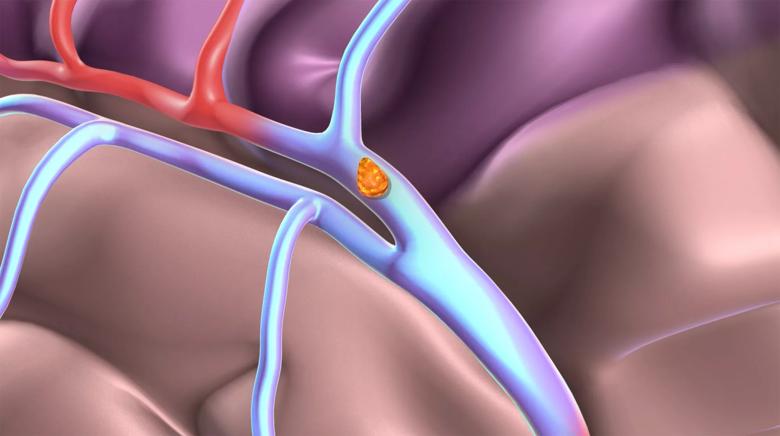Cleveland Clinic News Service | 216.444.0141
We’re available to shoot custom interviews & b-roll for media outlets upon request.
CCNS health and medical content is consumer-friendly, professional broadcast quality (available in HD), and available to media outlets each day.

The “golden hour” is proving to live up to its name, even for patients with one of the most serious forms of ischemic stroke.
According to a Cleveland Clinic study, 52 percent of individuals suffering an ischemic stroke caused by very large blood clots had better long-term outcomes if they received the IV-administered tissue plasgminogen activator (IV tPA) medication within 60 minutes of symptom onset. This compares to only 27 percent of patients showing good long-term outcomes – with respect to disability and living independently — if administered IV tPA beyond the golden hour.

tPA in the bloodstream getting ready to dissolve the clot and improve bloodflow.“Previous data had indicated IV tPA wasn’t very effective in treating large blood clots,” said M. Shazam Hussain, MD, director of Cleveland Clinic Cerebrovascular Center. “Our data provides a counter argument to that, suggesting that if we’re able to get these patients the drug very, very quickly, it actually can be highly effective.”
RELATED: 5 Stroke Signs: Knowing Them Could Save Someone’s Life
Dr. Hussain presented the findings from the Cleveland Clinic study at the International Stroke Conference 2018 in Los Angeles.
While the efficacy of treatment in the golden hour is well documented in the stroke treatment community, IV tPA was generally considered to be only effective in dissolving blood clots and improving blood flow to the brain for less severe strokes. The new study – a retrospective chart review of patients treated at Cleveland Clinic from 2013 through 2016 – found those with emergent large vessel occlusions (ELVO) also benefitted from IV tPA if administered in the golden hour.
RELATED: Benefits of Ultra-Early IV tPA Extend to Emergent Large Vessel Occlusions Too
Other study findings that indicated the positive impact of golden hour treatment of ELVO stroke patients by IV tPA included the following:
RELATED: Stroke of Luck (Patient Story)
“These findings support our efforts to decrease the amount of time it takes to begin treatment with IV tPA, and in using novel approaches including mobile stroke treatment units (MSTU),” Dr. Hussain added, which are ambulances specially equipped with emergency personnel, a CT scanner, point-of-care lab equipment and a telemedicine connection so that stroke-specific care can begin faster.
Each year, over 200,000 Americans suffer a stroke, which occurs when a vessel in the brain ruptures or is blocked by a blood clot. However, 80 percent of strokes are preventable.
Cleveland Clinic is a nonprofit multispecialty academic medical center that integrates clinical and hospital care with research and education. Located in Cleveland, Ohio, it was founded in 1921 by four renowned physicians with a vision of providing outstanding patient care based upon the principles of cooperation, compassion and innovation. Cleveland Clinic has pioneered many medical breakthroughs, including coronary artery bypass surgery and the first face transplant in the United States. Cleveland Clinic is consistently recognized in the U.S. and throughout the world for its expertise and care. Among Cleveland Clinic’s 82,600 employees worldwide are more than 5,786 salaried physicians and researchers, and 20,700 registered nurses and advanced practice providers, representing 140 medical specialties and subspecialties. Cleveland Clinic is a 6,728-bed health system that includes a 173-acre main campus near downtown Cleveland, 23 hospitals, 280 outpatient facilities, including locations in northeast Ohio; Florida; Las Vegas, Nevada; Toronto, Canada; Abu Dhabi, UAE; and London, England. In 2024, there were 15.7 million outpatient encounters, 333,000 hospital admissions and observations, and 320,000 surgeries and procedures throughout Cleveland Clinic’s health system. Patients came for treatment from every state and 112 countries. Visit us at clevelandclinic.org. Follow us at x.com/CleClinicNews. News and resources are available at newsroom.clevelandclinic.org.
Editor’s Note: Cleveland Clinic News Service is available to provide broadcast-quality interviews and B-roll upon request.